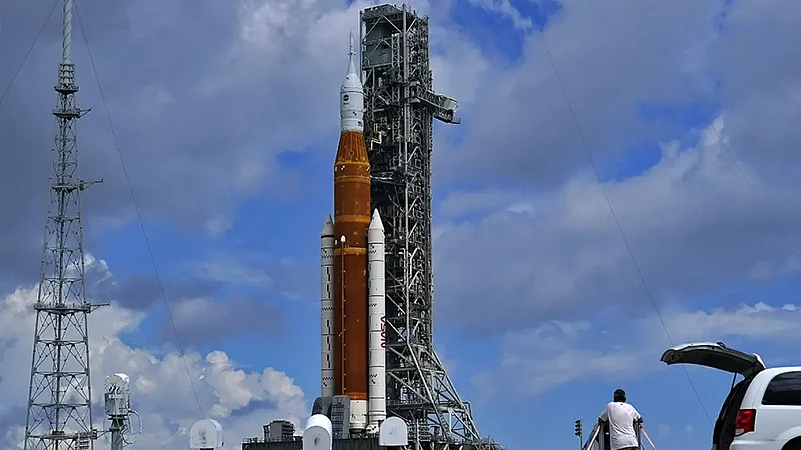There is growing competition between the US space agency NASA and Chinese CNSA in space and on the Moon.
While NASA's ambitious Artemis program is stalled for now as it's grappling with multiple technical malfunctions, the Chinese space agency CNSA is pushing ahead with three Moon missions.
Both the United States and China plan to build a base camp on the Moon. The NASA's stated plans are much more ambitious than just lunar exploration. It plans to use Moon as the stepping stone to reach Mars and for further space exploration.
Here we explain the competing Chinese moon missions, how the US Artemis program marks the dawn of the new age, and how the competition betwen the United States and China could lead to a new space race, similar to the US-Soviet race during the Cold War.
What is the NASA Artemis space program?
The United States is the only country to have landed humans on the Moon, with the last landing around five decades back.
The Artemis space program consists of three missions, the first of which was scheduled to be launched with the Space Launch System (SLS) on 29 August and later on 3 September. Launches were called off on both the days because of technical malfunctions.
Artemis I will send the SLS rocket into space. It is the world's most powerful rocket.
Artemis I is an uncrewed mission to test the functioning of the rocket. The SLS rocket will carry the Orion spacecraft. It will drop Orion into space where it will travel past the Moon and cover 1.3 million miles before splashing down on Earth at the end of its 42-days journey.
There will be three human models on Orion, one of which will be in the commander's seat. These three models will be fitted with censors to check how the unprecedented space journey would affect the human body. It will help prepare for crewed missions in the next two Artemis missions..
Artemis II will be the first crewed flight test of the SLS rocket and the Orion spacecraft around the Moon, according to NASA.
Artemis II will make a journey similar to Artemis I but with humans. It would make history as it would take humans to their farthest point yet in space.
"Astronauts on their first flight aboard NASA’s Orion spacecraft will travel farther into the solar system than humanity has ever traveled before," said NASA.
The mission can be launched in 2024 and will pave the way for Artemis III which would finally land humans on the Moon.
Artemis III will make history by landing humans on the Moon for the first time in over five decades.
Artemis program's ambitious goals, dawn of new space age
Artemis space program does not just intend to explore the Moon bur plans to establish long-term presence there. Moon would become the stepping stone in the journey to Mars.
"We will collaborate with commercial and international partners and establish the first long-term presence on the Moon. Then, we will use what we learn on and around the Moon to take the next giant leap: sending the first astronauts to Mars," said NASA.
As for the stated objectives, the NASA said that they are "going back to the Moon for scientific discovery, economic benefits, and inspiration for a new generation of explorers: the Artemis Generation".
The program is therefore much more than merely sending humans on Moon. It is extending human presence from Earth to Moon and it could possibly be the first step in turning the human race into an inter-planetory specie.
Vox explains: "The Artemis program is laying the groundwork for an unprecedented level of activity on the lunar surface, including a human base camp, a series of nuclear reactors, and a mineral mining operation. NASA has expressly said that it wants to develop a lunar economy, and the space agency has also established the Artemis Accords, a set of principles for exploring the moon that more than 20 countries have now joined."
China's Moon missions, competing with USA
China recently authorised three missions to the Moon, which compete with the United States in their objectives.
The three missions are intended to lay groundwork for a permanent research station on the Moon, which China is expected to develop with Russia.
Space.com reports details of the three missions:
1. Chang'e 6 will repurpose 2020 Chang'e 5 lunar sample-return mission's spacecraft for the first-ever attempt at collecting samples from the far side of the Moon. CNSA has not provided any timeline for the mission.
2. Chang'e 7 will target the South Pole of the Moon and would include the hunt for water on Moon. "The mission will consist of an orbiter, lander, rover, relay satellite and a small detector that can hop into craters to hunt for water," reports Space.com
3. Chang'e 8 is intended to test technologies for 3D printing and for using local resources of the Moon.
Besides these three missions, China has made a number of advances in space and on the Moon.
"China has accelerated its efforts in space exploration of late by building a space station, launching a number of missions to collect moon samples and putting a rover called Zhurong on Mars earlier this year to rival NASA," reports Business Insider.
Space.com reports, "In successive missions, the nation [China] has successfully launched first a pair of orbiters, then a lander and a rover; conducted the only far-side lunar landing to date; and most recently executed a complex sample-return mission...China is planning a project named the International Lunar Research Station (ILRS) in collaboration with Russia for the 2030s and is seeking partners to join the endeavor."
New space age and new space race
The goals as well as the nature of spacefaring has evolved between the Cold War decades and now.
Earlier, only White men had landed on Moon. The Artemis program will land the first woman and first person of colour to the Moon.
Unlike before, the objective is not just to beat the other superpower in reaching the space and Moon, but in stepping deeper into the space.
However, the emergence of China as a spacefaring nation and overlapping of its objectives with that of the United States have led to a sense of rivalry that's expected by some quarters to evolve into a new space race.
"Moon mining could be the next source of tension between the countries as NASA is also probing the moon's south pole where China plans to build a research station in conjunction with Russia," reports the Insider.
American leaders have already highlighted the challenge posed by China, noting that the United States is no londer the unquestioned leader in space.
"In a decade, the United States has gone from the unquestioned leader in space to merely one of two peers in a competition. Everything our military does relies on space," said Republican Senator Jim Inhofe.
The moon programs signal that "space is going to be an arena of competition on the prestige front, demonstrating advanced technical expertise and know-how, and then also on the military front as well", said Aaron Bateman to the Associated Press.
"People who are supportive of Artemis and people who see it as a tool of competition, they want the United States to be at the table in shaping the future of exploration on other celestial bodies," said Bateman, a professor at George Washington University and a member of the Space Policy Institute.
There is also military dimension to the space race, reports AP, quoting the US intelligence community as having said earlier this year that "Beijing is working to match or exceed US capabilities in space to gain the military, economic, and prestige benefits that Washington has accrued from space leadership".
The US government has also seen teh rise of China in space as part of the democracy versus authoritarianism competition, as the United States sees itself as the Leader of the Free World whereas Russia leads the autoritarian parts of the world, with partners such as Russia and North Korea.
The AP reports a Pentagon-commissioned study group contended last month that "China appears to be on track to surpass the US as the dominant space power by 2045" and further called that part of a Chinese plan to promote authoritarianism and communism on Earth.
However, as of now, China remains a generation behind the United States in its space mission. But it's catching up fast. While the United States is set to launch Artemis I and is already in advanced stages of Artemis II and III, China has just sanctioned its three missions. The United States continues to have the edge for now. However, this edge rests entirely on the success of Artemis I, whose launch has been aborted twice in the past two weeks.
Artemis I launch cancellations, what's next for it?
The launch of SLS rocket, which would Artemis I mission into space, was cancelled first on 29 August and then on 3 September.
On 29 October, The Verge reported, that "NASA scientists determined that engine number three [of SLS rocket] could not reach the appropriate temperature range to allow for a launch" and this led to the launch being called off. The engines need to be reach a very cold temperature to process the super-cold liquid fuel used in the rocket.
NASA personnel tried to repair the issue but troubleshooting was not successfull and the launch was eventually postponed. Prior to the temperature issue, there was a leakage during the fuelling of the rocket that was eventually resolved. There was yet another issue, reported Space.com, of a suspected crack in the part of the rocket that connects the liquid hydrogen and liquid oxygen tanks of the rocket.
On 3 September, the launch was cancelled again because of hydrogen leakage during the fuelling process. The leakage was different in nature than the one witnessed earlier on 29 October.
"The problem was traced to the connection where the hydrogen was being pumped into the vehicle. Controllers tried a number of fixes, including allowing the hardware to warm up for short periods, hoping this might reset the seal. But without success," explained BBC at the time.
The next date for the launch of Artemis I is 27 September. Failing to launch on 27th, another attempt would be made on 2 October.
NASA said it has sorted out the issues that prevented the previous launch attempts.
"Over the weekend, Artemis I teams completed repair work to the area of a hydrogen leak, reconnecting the ground- and rocket-side plates on the quick disconnect for the liquid hydrogen fuel feed line where two seals were replaced last week," said NASA on Monday.
The Artemis space program is the most ambitious space program ever in history. The SLS rocket taking Artemis I into space is the most powerful space rocket. The United States has the edge over China in spacefaring. The sustainment and success of every one of these things hinges on the successful launch of Artemis I.
Other countries planning Moon missions
While the United States remains the leader in spacefaring and China competes with it, there are other countries too that have planned Moon missions.
India is also among those countries. Besides India, Japan, South Korea, Russia, and the United Arab Emirates (UAE) are also in the race to land on Moon.
However, countries like India are farely new and while India has has many notable successes such as its Mission to Mars, there have been failures as well, putting into questions the success of these aspiring spacefarers.
"Even if missions depart from Earth as scheduled, there is no guarantee of their success. India’s last lunar mission, Chandrayaan-2, succeeded in getting a spacecraft into orbit in 2019, but its lander and rover crashed when they tried to land. Israel’s privately developed Beresheet lander also smashed into the surface earlier that year," notes Nature.
India currently aims to become the fourth country in the world to launch a human spaceflight after the United States, Russia, and China. It was initially scheduled for 2021 but it got delayed due to Covid-19 pandemic. Now India's Gaganyaan mission is scheduled to be launched in 2024.
"The Gaganyaan programme will lay the foundation for a sustained Indian human space exploration programme in the long run. Also, the objective of this mission is to demonstrate the indigenous capability to undertake human space flight," reports the Insider.


























